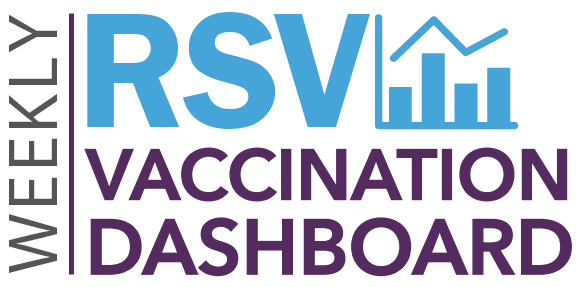About

Data Summary
Data Updates
Adults 60+ RSV Vaccination Coverage
RSV vaccination coverage estimates among adults 60 years and older are based on data from CDC's National Immunization Survey-Adult COVID Module. Estimates of vaccination coverage are based on respondent self-report. Data and charts are available here.
- As of May 11, 2024, an estimated 24.4% (95% Confidence Interval: 23.7%-25.2%) of adults 60 years and older reported having received an RSV vaccine.
- An additional 10.7% (8.8%-12.7%) reported that they definitely plan to get vaccinated.
- Vaccination coverage among White adults [26.8% (25.9%-27.8%)] was higher than coverage among Asian [19.1% (15.8%-22.4%)], Black [20.9% (18.7%-23.1%)], multiple or Other race [16.5% (13.3%-19.8%)], Hispanic [14.7% (12.5%-17.0%), and Pacific Islander/Native Hawaiian [16.1% (5.8%-26.4%)] adults.
- Vaccination coverage consistently varied by age, poverty status, health insurance status, urbanicity, sex, race and ethnicity, sexual orientation, gender identity, and presence of a chronic medical condition.
- Across states and the District of Columbia, receipt of an RSV vaccine was lowest in Mississippi [14.2% (11.6%-16.7%)] and highest in Colorado [32.2% (27.5%-37.0%)].
- Additional RSV vaccination data by demographic characteristics at the national level and overall estimates by jurisdiction are available.
Monthly Jurisdiction Vaccine Administration and Coverage
RSV vaccination coverage estimates as of the end of March 2024 based on IIS data submitted to CDC by 50 immunization awardee jurisdictions. Data and charts are available here.
- Among the currently reporting 42 state and city IIS jurisdictions, RSV vaccination coverage among adults 60 years and older ranged from 1.0% to 21.0%. Among 8 U.S. territorial and affiliated island jurisdictions, coverage ranged from 0.0% to 4.4%.
Adults 65 Years and Older (Medicare Fee-for-service) RSV Vaccination Coverage
RSV vaccination coverage among Medicare fee-for-service beneficiaries 65 years and older and enrolled in a Part D plan is assessed using data files from the Medicare Fee-For-Service administrative claims data managed by the Centers for Medicare & Medicaid Services. Data and charts are available here.
- As of March 30, 2024, an estimated 20.2% of Medicare fee-for-service beneficiaries 65 years and older enrolled in Part D plan were vaccinated.
- Estimates by race and ethnicity group: 6.1% of Hispanic adults, 11.4% of Black, non-Hispanic adults, 21.0% of White, non-Hispanic adults, 20.0% of adults of Other, non-Hispanic race and ethnicity, and 16.3% of Asian, non-Hispanic adults were vaccinated.
RSV Vaccinations Administered in Pharmacies and Medical Offices
RSV vaccinations administered at retail pharmacies and American Medical Association (AMA) physicians' medical offices for adults 60 years and older based on healthcare claims data. Data and charts are available here.
- As of April 27, 2024, an estimated 10.22 million doses were administered in retail pharmacies and an estimated 357,750 doses were administered in physicians' medical offices to adults 60 years and older.
Pregnant Persons RSV Vaccination Coverage
RSV vaccination coverage estimates for pregnant persons 18 to 49 years are based on data from CDC's Vaccine Safety Datalink. Estimates of vaccination coverage are based on electronic health data from multiple integrated health systems. Data and charts are available here.
The period of recommendation for maternal RSV vaccination ended for most of the continental U.S. on January 31, 2024, and data for pregnant persons was not assessed beyond January 31, 2024. Estimates for prior weeks were updated for the final time on April 10 with data for pregnant persons who reached at least 32 weeks gestation and vaccinations received before January 31st, 2024, that were identified retrospectively.
- As of January 31, 2024, among persons who were pregnant and ≥32 weeks gestation since September 22, 2023, overall coverage with the RSV vaccine was 17.8%.
- Vaccination coverage was highest among non-Hispanic Asian (24.8%) pregnant persons and lowest among non-Hispanic Black (10.3%) pregnant persons.
Monthly Nirsevimab Coverage and Intent for Infants
Monthly nirsevimab coverage and intent estimates reported by females age 18-49 years with infants <8 months, females age 18-49 years who are currently pregnant, and females age 18-49 years who are currently trying to get pregnant, are based on data from CDC's National Immunization Survey-Adult COVID Module. Estimates of nirsevimab coverage and intent are based on respondent self-report. The period of recommendation for the use of nirsevimab ended for most of the continental U.S. on March 31, 2024, and data were not added beyond March 31, 2024. Data and charts are available here.
- As of March 2024, among females with an infant <8 months, 41.3% reported that their infant received nirsevimab.
Monthly Jurisdiction Nirsevimab Administration and Coverage
Nirsevimab administration and coverage estimates among infants aged <8 months as of the end of March 2024 based on IIS data submitted to CDC by 50 immunization awardee jurisdictions. These data do not include doses administered to infants born on or after October 1, 2023, and information on maternal vaccination status is not reported and not considered when calculating nirsevimab coverage. Data and charts are available here.
- Among the currently reporting 42 state and city IIS jurisdictions, nirsevimab coverage among infants <8 months ranged from 2.4% to 22.8%. Among 8 U.S. territorial and affiliated island jurisdictions, coverage ranged from 0.0% to 14.9%.
Data & Charts
Data & Charts
- Adults 60+ RSV Vaccination Coverage and Intent (NIS)
- RSV Vaccine Administration and Coverage by Jurisdiction (IIS)
- Adults 65+ RSV Vaccination Coverage (CMS)
- RSV Vaccinations Administered in Pharmacies and Medical Offices (IQVIA)
- Pregnant Persons RSV Vaccination Coverage (VSD)
- Nirsevimab Coverage and Intent for Infants (NIS)
- Nirsevimab Administration and Coverage by Jurisdiction (IIS)
Other VaxView Vaccination Coverage Websites
The VaxView websites provide vaccination coverage data for all ages. Monitoring coverage for recommended vaccinations across the country helps CDC assess how well local areas, states, and the nation are protected from vaccine-preventable diseases.
Find vaccination coverage data at:
Prevent RSV
Adults 60 years and older and pregnant persons can protect themselves from RSV.
Learn more about RSV.
